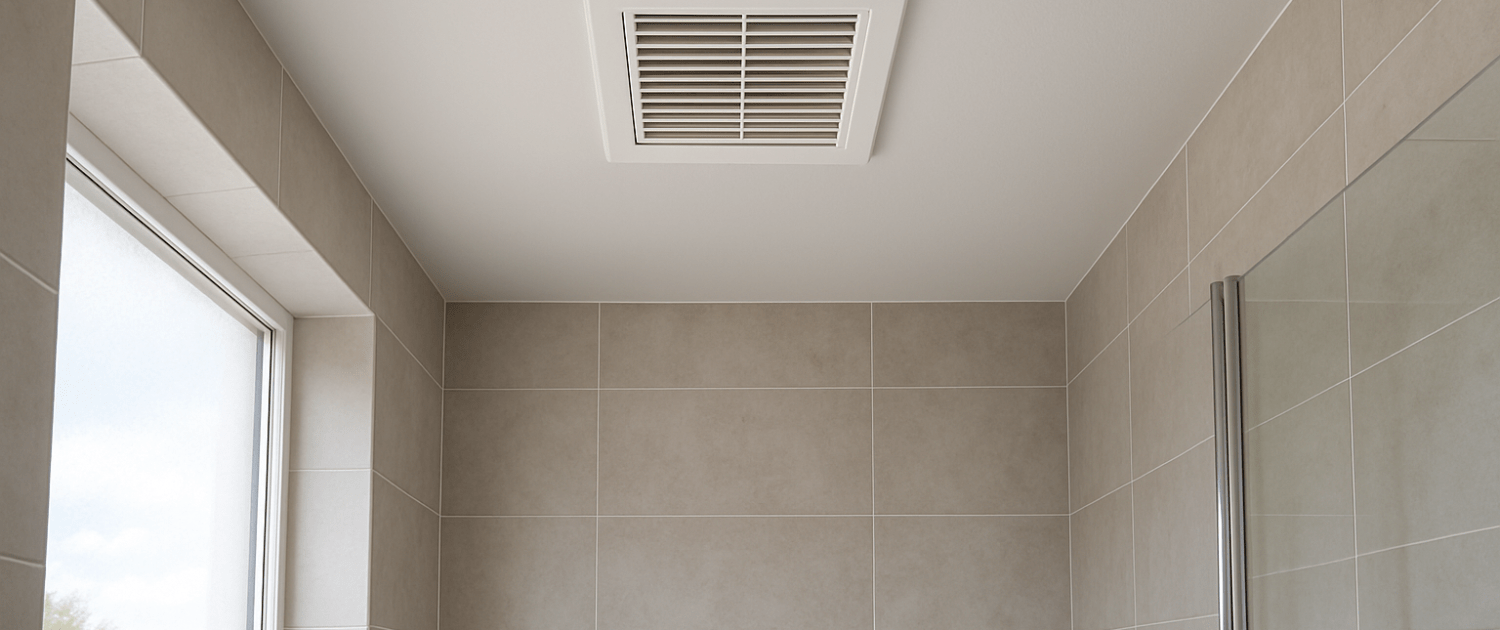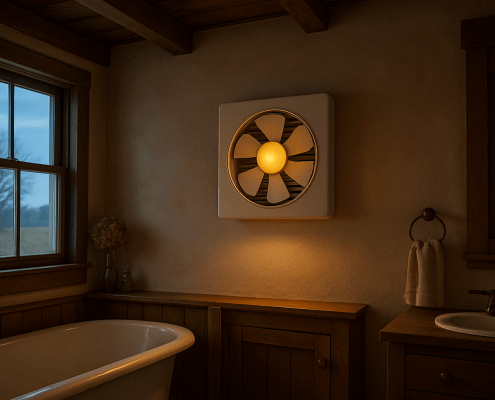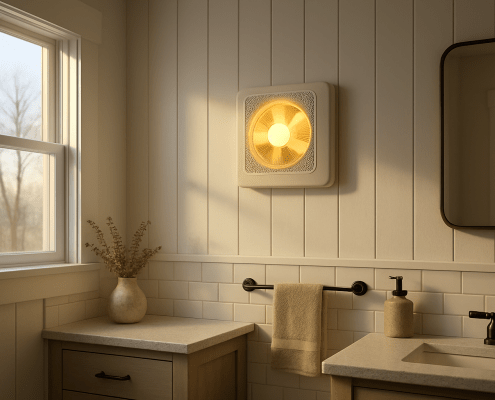Where to Install a Bathroom Fan: Installation Safety Zone Guide
Steven E / Monday June 30, 2025
Installing a bathroom exhaust fan may seem simple, pick a spot on the ceiling, wire it up, and let it run. But there’s more to proper installation than just convenience. Where you install your bathroom fan plays a big role in how well it removes moisture and odors, how safely it operates, and whether it meets building codes and manufacturer recommendations.
This article will help you understand installation zones for bathroom fans, what they are, why they matter, and how to make sure your fan is placed for optimal performance and safety.
The information in this article may not apply to your specific appliance model. We recommend consulting your manufacturer’s documentation or contact us with any questions.
Why Installation Zones Matter
Bathroom fans are meant to do one primary job: remove humid, stale air from your bathroom and exhaust it outside. But they can only do that efficiently if they’re located in the right place.
Improper fan placement can result in:
- Ineffective moisture removal
- Mold and mildew growth in corners and crevices
- Short fan life due to exposure to excessive steam or incorrect installation
- Code violations, especially if the fan is too close to wet zones without the proper rating
The Basics of Bathroom Fan Placement
Most bathrooms are divided into zones based on their proximity to water sources. These zones help determine what type of fan can be installed in each area, especially when dealing with electrical safety near bathtubs, showers, or sinks.
Key goals for fan placement:
- Capture rising steam before it spreads
- Avoid direct contact with water spray
- Maintain code-compliant electrical safety
- Prevent heat buildup around the fan motor
- Allow easy access for future maintenance
Common Installation Zones
While codes may vary slightly by region, here’s how most bathrooms are categorized in terms of electrical installation zones (based on common interpretations of NEC and international standards):
Zone 0: Inside the Bathtub or Shower Basin
- Definition: The interior of a bathtub or the area directly under the showerhead or floor basin.
- Fan installation allowed? No. Electrical appliances, including fans, are not allowed in this zone unless explicitly designed to be submerged (which most fans are not).
- Why it matters: Installing anything electrical in Zone 0 is extremely hazardous and a clear code violation.
Zone 1: Directly Above the Bathtub or Shower
- Definition: The vertical area directly above a tub or shower up to 8 feet from the floor.
- Fan installation allowed? Yes, but only if the fan is rated for use in wet areas and protected by a GFCI (ground fault circuit interrupter).
- Best practices: Use a fan that’s UL listed for wet locations, and be sure it’s connected to a GFCI-protected circuit. Most fans rated for this zone will indicate “for use over tubs or showers” in their specifications.
Zone 2: Area Within 2–3 Feet of the Bathtub or Shower Edge
- Definition: The perimeter zone extending 2 to 3 feet horizontally around a tub or shower.
- Fan installation allowed? Yes, but fans installed here should be rated for damp locations.
- Why it matters: These areas are prone to high humidity but are not typically subject to direct water spray.
Zone 3: General Bathroom Area (Beyond 3 Feet from Shower/Tub)
- Definition: All areas of the bathroom that fall outside Zones 0–2.
- Fan installation allowed? Yes. Standard bathroom fans (damp-rated) can be used here with no special requirements.
- Best practices: This is the ideal area for ceiling-mounted fans in powder rooms or large bathrooms without a separate enclosed shower space.
Ventilation Efficiency Considerations
Beyond code-compliance, you want your fan to be effective. Just placing it in a safe zone isn’t enough, location matters for airflow, noise, and moisture removal.
Best Placement Practices:
- As close to the source of moisture as safely possible – ideally above or near the shower or tub.
- Central location if covering the whole bathroom – in small bathrooms, a centrally located fan may suffice for ventilation.
- Avoid installation near air conditioning or heating vents – competing airflow can reduce the fan’s effectiveness.
- Don’t install directly above light fixtures unless it’s a fan-light combo designed for that purpose.
- Use more than one fan in larger bathrooms – this ensures more even ventilation and coverage in areas like water closets or vanities with poor airflow.
Height Considerations
Bathroom fans should be installed:
- At least 7 feet above the floor (or ceiling-mounted), to capture rising steam.
- Not in contact with insulation unless the fan is IC-rated (Insulation Contact rated).
- With adequate clearance around the housing, especially if the fan also includes lighting or heating.
Always refer to the manufacturer’s installation guide for minimum spacing and placement details.
Code Compliance and Electrical Safety
Local codes may adopt the National Electrical Code (NEC) or international equivalents that govern fan placement and protection. While fans are relatively simple appliances, they must be wired correctly and installed in approved locations, particularly near water.
Key code considerations:
- Fans in wet locations must be GFCI-protected
- Wiring must follow proper grounding and insulation rules
- Ducting must exhaust outdoors (never into attics or crawlspaces)
- Bathrooms with no windows must have mechanical ventilation
Some municipalities require permits for bathroom remodels involving electrical work. When in doubt, consult your local building department or a licensed electrician.
Using Inline Fans for Flexible Placement
If you’re struggling to find a good ceiling location due to space constraints, consider an inline fan system. These fans mount remotely, typically in the attic, and connect to a vent cover in the ceiling via flexible ductwork.
Advantages:
- Quieter operation, since the motor is housed away from the bathroom
- Can serve multiple locations (like a toilet area and shower stall)
- Easier to install when space above the ceiling is tight or access is limited
Inline fans offer flexibility when traditional fan housings won’t fit or when you need to serve oddly shaped or partitioned bathrooms.
Where To Find Us
If you need any replacement parts for your appliances, you can enter your model number at AppliancePartsPros.com to locate and order them quickly. Most orders arrive in just two business days, and we have tons of great information in our repair help section and YouTube videos to help you troubleshoot.
Stay connected with the latest DIY tips, tutorial videos, and repair guides by following us on Facebook, Instagram, and Twitter. We love hearing about your repair stories and successes. If you need more help or want personalized guidance, feel free to reach out. We’re ready to help you take on your next project with confidence!
With nearly a decade of experience in providing top-notch customer service regarding appliance parts and repair, Steven enjoys sharing practical advice, troubleshooting tips, and interesting information to help readers stay informed.





